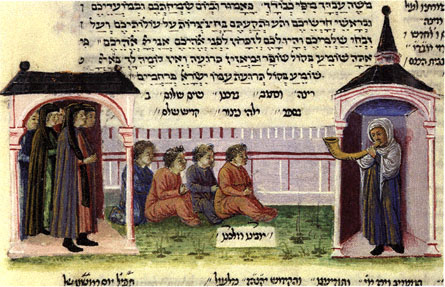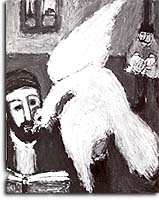 |
 |
Yom Kippur
The Day of Atonement

The shofar is blown by the Rabbi at the end of services of Yom Kippur
| The Meaning of Yom Kippur | Power of Yom Kippur | Rituals | Conclusion |
"for it is on this day that atonement shall be made for you to cleanse you;
you will be clean from all your sin before the LORD." -Leviticus 16:30
Yom Kippur literally means the "Day of Atonement". The holiday is just a few days after the Jewish new year. Although differences are noticeable within each branch of Judaism, the underlying principles involved in Yom Kippur are the same. Yom Kippur is a time for individuals to atone for their sins of the past year. This is done in order to start the new year fresh, unburdened by past actions. The holiday celebrates both a spiritual cleansing and a new beginning. The day itself is a culmination of the Ten Days of Repentance, Yom Kippur being the most serious of the Ten Days. It is widely considered the most important Jewish holiday.
Arguably, Yom Kippur is the most important and most powerful of the Jewish holidays. The power the day holds can be understood by the sheer number of Jews that attend services. The majority of Jews, even ones that usually do not attend services, will be on hand. Sandy Koufax provides an excellent example in showing how seriously Jewish people take Yom Kippur. Koufax, a Conservative Jew, may be the greatest pitcher in baseball history. Without a doubt, he's the greatest Jewish player ever. In 1965 he declined to pitch Game 1 of the World Series against the Minnesota Twins because it fell on Yom Kippur. Koufax understood that Yom Kippur takes precedence over everything else. The large turnout becomes more impressive after one understands the sacrifices that are made during the day. The day itself and the services emphasize self-examination and repentance of sins. Interestingly, it's the only Jewish holiday that places an extreme emphasis on an individual's personal covenant with God. A person celebrates his or her covenant with God at the same time seeking atonement for the sins of the previous year. One of the reasons Yom Kippur holds such power is because the holiday emphasizes both personal and communal confessional aspects. Individuals atone for personal sins against God, while the entire community prays and worships together, thus celebrating both the communal and individual relationships with God. The celebration of the individual covenant with God strengthens the individual's bond with God while giving due respect to divine power. The community prays for atonement regarding the sins of the entire people.
| During Yom Kippur, Jews refrain from work of any kind, spending the majority of the day fasting, praying and attending services. As mentioned previously, although the basic principles of Yom Kippur are constant within all forms of Judaism, the rituals of the day do vary. The biggest differences can be seen within the Orthodox and Reform Jewish traditions. Both branches of Judaism refer to the day as the "Sabbath of all Sabbaths". Interestingly, some people of ultra-Orthodox tradition still celebrate the ancient custom of Kapparot. This ritual is meant as a good deed performed for those of less fortune. The ritual can be performed with either money or a chicken, usually money. Either way, a prayer is said as the sacrifice is swung around one's head. Although very rare, if in fact a live chicken is used it is then killed and given to someone less fortunate. More often than not, a sum of money is given to charity as a good deed. Kapparot is still performed by some people because Yom Kippur traditionally involved sacrifice. Before the Temple was destroyed, sheep were sacrificed to God to repent for community sins. Another ritual performed for the sake of atonement is that of Tashlich which means to "cast away". Tashlich is a more common ritual then Kapparot, considering that all branches of Judaism do perform it. Traditionally, the ritual is performed during Rosh Hashana by a Rabbi who leads people to a flowing body of water, the Rabbi says a few prayers and the people throw pieces of bread into the water. The bread itself is symbolic of previous sins and the scriptural reason for it can be seen in the bible "And Thou wilt cast all their sins into the depths of the sea". (Michah, 7:19) Both rituals focus on the main theme of Yom Kippur, that of atonement and both reflect the power of the holiday. |  Kapparot Kapparot |
Yom Kippur, the most important Jewish holiday shows the power of religion within society. The sacrifices, although they initially may seem minor are very strict in a relative, religious context. Few modern religions require the amount of asceticism that is evident within Yom Kippur. For people that are not familiar with Judaism they may better understand the seriousness of the day with the example of the great Dodger baseball player, Sandy Koufax. A man that placed the most important religious day of his people over pitching Game 1 of the 1965 World Series. With his actions he showed the world the power of Yom Kippur, choosing to pray instead of pitch. Proving to a sports crazed nation, the influence of Yom Kippur on the Jewish people. To understand Koufax is to understand the sacrifices of the Jewish people as a community, and the power of Yom Kippur within Judaism.
Sources
For information on Jewish holidays: